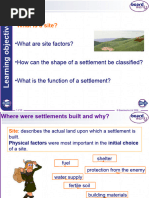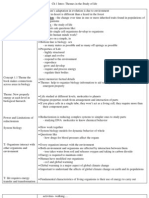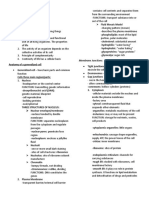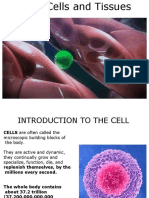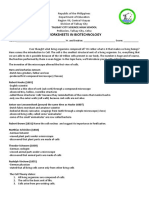0 ratings0% found this document useful (0 votes)
17 viewsCells
Cells
Uploaded by
rodrigo.a.chavez.zCopyright:
© All Rights Reserved
Available Formats
Download as PPT, PDF, TXT or read online from Scribd
Cells
Cells
Uploaded by
rodrigo.a.chavez.z0 ratings0% found this document useful (0 votes)
17 views31 pagesCopyright
© © All Rights Reserved
Available Formats
PPT, PDF, TXT or read online from Scribd
Share this document
Did you find this document useful?
Is this content inappropriate?
Copyright:
© All Rights Reserved
Available Formats
Download as PPT, PDF, TXT or read online from Scribd
Download as ppt, pdf, or txt
0 ratings0% found this document useful (0 votes)
17 views31 pagesCells
Cells
Uploaded by
rodrigo.a.chavez.zCopyright:
© All Rights Reserved
Available Formats
Download as PPT, PDF, TXT or read online from Scribd
Download as ppt, pdf, or txt
You are on page 1of 31
Cells
1 of 31 © Boardworks Ltd 2012
2 of 31 © Boardworks Ltd 2012
What are living things made of?
Cells are the building
blocks of life – they come
in all shapes and sizes.
Some organisms are
unicellular – they are
made up of only one cell.
Other organisms are multicellular – they are made
up of many types of cells. Can you think of some
examples of unicellular and multicellular organisms?
Cells work together to carry out the seven life processes
that are needed for an organism to stay alive.
3 of 31 © Boardworks Ltd 2012
What are the seven life processes?
4 of 31 © Boardworks Ltd 2012
How big is a cell?
Most plant and animal cells are between 10 µm and
100 µm in size – around the diameter of a human hair –
and too small to see without a microscope.
The largest cell in
the human body is
the female egg cell,
(ovum) at around
100 µm in diameter.
The smallest human cell is the sperm cell – the head is
around 5 µm long.
5 of 31 © Boardworks Ltd 2012
Comparing micro-organisms
6 of 31 © Boardworks Ltd 2012
Microscopes
Thanks to advances in microscope technology, we can
see micro-organisms with far greater detail and clarity
than was possible in the past.
size of image
magnification =
actual size of the object
When Antonie van Leeuwenhoek discovered single-
celled organisms in 1676, his microscope could magnify
an image up to 500 times. Now, with the use of electron
microscopes, scientists can attain a magnification as high
as 2×106.
7 of 31 © Boardworks Ltd 2012
Specialized cells
Most plants and animals are multicellular. The human
body is made up of around 200 different types of cell,
all working together.
Most cells are specialized, meaning
that each type of cell has a specific
structure and function.
All cells with a nucleus contain the
same genes, but different cells
activate different genes so they only
produce the proteins they need.
However, all cells have certain
common features and structures
called organelles.
8 of 31 © Boardworks Ltd 2012
What do cells contain?
9 of 31 © Boardworks Ltd 2012
Animal or plant?
10 of 31 © Boardworks Ltd 2012
Microbial cells
11 of 31 © Boardworks Ltd 2012
Bacteria
Unlike other cells, bacteria have no distinct nucleus.
Instead, their genetic material is contained within a coiled
cluster of chromosomal DNA and a single circular strand
of plasmid DNA.
Plasmid DNA can reproduce
independently of chromosomal DNA,
and can be transferred to other cells.
Bacteria also lack mitochondria
and chloroplasts. Some bacteria
have one or more flagella, which
are used for locomotion.
12 of 31 © Boardworks Ltd 2012
13 of 31 © Boardworks Ltd 2012
A closer look at animal cells
14 of 31 © Boardworks Ltd 2012
Exploring animal cells
15 of 31 © Boardworks Ltd 2012
How are animal cells adapted?
16 of 31 © Boardworks Ltd 2012
Animal cells: fit for a purpose
17 of 31 © Boardworks Ltd 2012
18 of 31 © Boardworks Ltd 2012
A closer look at plant cells
19 of 31 © Boardworks Ltd 2012
Exploring plant cells
20 of 31 © Boardworks Ltd 2012
How are plant cells adapted?
21 of 31 © Boardworks Ltd 2012
Plant cells: fit for a purpose
22 of 31 © Boardworks Ltd 2012
What is a cell wall?
All plant cells have a cell wall –
a rigid layer that surrounds the
cell membrane.
The plant cell wall is made
from cellulose, a
carbohydrate polymer. The
purpose of the cell wall is to:
maintain the shape and structure of the cell
protect the cell’s contents from pathogens
prevent damage to the cell caused by excess water intake.
Unlike the cell membrane, the cell wall is freely
permeable to water and other molecules.
23 of 31 © Boardworks Ltd 2012
What is a vacuole?
The vacuole is a fluid–filled
sac found within plant cells
and some bacteria.
The vacuole has a range of
functions, including:
storing waste products
maintaining the water and pH balance of the cell
maintaining the shape of the cell.
The size of vacuoles depend on how much water the plant
has absorbed.
24 of 31 © Boardworks Ltd 2012
What are chloroplasts?
Chloroplasts are the site of photosynthesis
in plant cells.
A green pigment in chloroplasts
called chlorophyll absorbs the
energy in sunlight.
This energy is used to
convert carbon dioxide
and water into glucose
and oxygen.
25 of 31 © Boardworks Ltd 2012
Which organelle?
26 of 31 © Boardworks Ltd 2012
Make a cell model
You can make your own 3-D cell
using the following items:
a plastic bag
clear gelatin
small objects to suspend in
the cellulose paste (these
will represent the internal
structures of the cell).
Can you make a model of a
typical plant or animal cell?
27 of 31 © Boardworks Ltd 2012
28 of 31 © Boardworks Ltd 2012
Glossary
29 of 31 © Boardworks Ltd 2012
Anagrams
30 of 31 © Boardworks Ltd 2012
Multiple-choice quiz
31 of 31 © Boardworks Ltd 2012
You might also like
- Genetics A Conceptual Approach 5e Pierce TBDocument16 pagesGenetics A Conceptual Approach 5e Pierce TBSerge GelinNo ratings yet
- Feeding Relationships: 1 of 38 © Boardworks LTD 2008Document124 pagesFeeding Relationships: 1 of 38 © Boardworks LTD 2008jspfoiguw89No ratings yet
- SBI3U Review NotesDocument19 pagesSBI3U Review NotesAnjali AhilanNo ratings yet
- اكثر من 400 سؤال مع الاجابة أسئلة الهيئة السعودية 2015 للمختصيين بالبكتريا والمياكروبيولجيDocument86 pagesاكثر من 400 سؤال مع الاجابة أسئلة الهيئة السعودية 2015 للمختصيين بالبكتريا والمياكروبيولجيMohsen HaleemNo ratings yet
- Bio Sol SheetDocument6 pagesBio Sol Sheetapi-110789702No ratings yet
- Bangor Biology Unit 1 2018Document69 pagesBangor Biology Unit 1 2018Daishaadil DilNo ratings yet
- Transport Across MembranesDocument33 pagesTransport Across Membraness1139221No ratings yet
- Finishing ProcessesDocument16 pagesFinishing ProcessesAjay P AntonyNo ratings yet
- chromatography - IGCSEDocument26 pageschromatography - IGCSETestNo ratings yet
- titrations - IGCSEDocument24 pagestitrations - IGCSETestNo ratings yet
- Developing Your PortfolioDocument57 pagesDeveloping Your Portfoliofitrus aliNo ratings yet
- Bar Charts Line Graphs and Pie ChartsDocument36 pagesBar Charts Line Graphs and Pie ChartsChuuNo ratings yet
- 3.2.5-1 - 2 Introducing Transition MetalsDocument57 pages3.2.5-1 - 2 Introducing Transition Metalsmilksheikh2004No ratings yet
- water_quality - IGCSEDocument17 pageswater_quality - IGCSETestNo ratings yet
- Site FactorsDocument8 pagesSite FactorsyounastNo ratings yet
- Simple CircuitsDocument33 pagesSimple CircuitskadebiyiojoNo ratings yet
- Settlement Functions and HierarchyDocument21 pagesSettlement Functions and HierarchyyounastNo ratings yet
- 16 Drugs and HygieneDocument37 pages16 Drugs and Hygieneapi-286702267No ratings yet
- The Passive Voice: Year 7 Sentence StartersDocument20 pagesThe Passive Voice: Year 7 Sentence StartersMuhammad KholikNo ratings yet
- Hard Water Free ContentDocument6 pagesHard Water Free ContentRandolph WoodroffeNo ratings yet
- 1 of 24 © Boardworks LTD 2009Document24 pages1 of 24 © Boardworks LTD 2009xatolom719No ratings yet
- Reaction Rates Worksheet-1452167356Document6 pagesReaction Rates Worksheet-1452167356feta cumaniNo ratings yet
- Ionic Bonding Worksheet-1452167300Document6 pagesIonic Bonding Worksheet-1452167300Regie BenignoNo ratings yet
- The Digestive System: 1 of 9 © Boardworks LTD 2015Document9 pagesThe Digestive System: 1 of 9 © Boardworks LTD 2015Aref DahabrahNo ratings yet
- Conservation of Mass WorksheetDocument2 pagesConservation of Mass Worksheetakasupergirl28No ratings yet
- 4. Religion Under the TudorsDocument24 pages4. Religion Under the TudorsinemisthebestNo ratings yet
- The History of Health and Medicine: ReviewDocument8 pagesThe History of Health and Medicine: ReviewWill TeeceNo ratings yet
- 12 Personal Exercise ProgrammesDocument18 pages12 Personal Exercise Programmesapi-286702267No ratings yet
- DiffusionDocument59 pagesDiffusionnisalielisha rodrigoNo ratings yet
- ComponentsDocument23 pagesComponentsMurugan.SubramaniNo ratings yet
- yield - IGCSEDocument13 pagesyield - IGCSETestNo ratings yet
- alcohols - IGCSEDocument23 pagesalcohols - IGCSETestNo ratings yet
- EthanolDocument15 pagesEthanolMr H BioNo ratings yet
- KS4 Physical Education: Eating WellDocument5 pagesKS4 Physical Education: Eating WellLee TeckBeeNo ratings yet
- covalent_bonding - IGCSEDocument19 pagescovalent_bonding - IGCSETestNo ratings yet
- 1 of 33 © Boardworks LTD 2009Document33 pages1 of 33 © Boardworks LTD 2009Romel B AgnoNo ratings yet
- Coastal ProcessesDocument15 pagesCoastal Processesapi-258813608No ratings yet
- HomeostasisDocument37 pagesHomeostasisfeysalshiiq4No ratings yet
- Action Potential BoardworksDocument13 pagesAction Potential BoardworksHffghgffhfNo ratings yet
- ConservationDocument37 pagesConservations1139221No ratings yet
- Momentum v1.1Document28 pagesMomentum v1.1Dessy Norma JuitaNo ratings yet
- Nanotechnology v1.0Document43 pagesNanotechnology v1.0Faizan AhmedNo ratings yet
- alloys副本Document18 pagesalloys副本TestNo ratings yet
- calculating_with_moles - IGCSEDocument30 pagescalculating_with_moles - IGCSETestNo ratings yet
- changing_the_atmosphere - IGCSEDocument24 pageschanging_the_atmosphere - IGCSETestNo ratings yet
- Chemical Analysis - Instrumental TechniquesDocument37 pagesChemical Analysis - Instrumental TechniquesleanneNo ratings yet
- The Atomic ModelDocument22 pagesThe Atomic ModelIntan CahyaningrumNo ratings yet
- Weather and Climate-Cs VersionDocument19 pagesWeather and Climate-Cs VersionjtNo ratings yet
- U8.2 Igneous Rock Formation 1Document7 pagesU8.2 Igneous Rock Formation 1Shame BopeNo ratings yet
- Boardworks High School Science Intermolecular ForcesDocument12 pagesBoardworks High School Science Intermolecular ForcesrattybatterNo ratings yet
- 3a. Circulatory SystemDocument5 pages3a. Circulatory Systemlangelihlencube620No ratings yet
- Mixtures and Solutions Yr 7Document46 pagesMixtures and Solutions Yr 7Dania El malkiNo ratings yet
- Pathway of BloodDocument4 pagesPathway of BloodSHC PE & SportNo ratings yet
- carboxylic_acids - IGCSEDocument31 pagescarboxylic_acids - IGCSETestNo ratings yet
- Digestive SystemDocument56 pagesDigestive SystemNimas PutriNo ratings yet
- Fractional Distillation WorksheetDocument2 pagesFractional Distillation WorksheetRxrock A.s.ANo ratings yet
- 8A Food and DigestionDocument28 pages8A Food and DigestionAri MayNo ratings yet
- Plant Nutrition Part 2Document16 pagesPlant Nutrition Part 2Nicolas SchroppNo ratings yet
- 5 DynamicsDocument67 pages5 DynamicsMurugan.SubramaniNo ratings yet
- Organic-Synthesis & ChiralityDocument34 pagesOrganic-Synthesis & ChiralityAlaa Al HamedNo ratings yet
- Thermodynamics Part 1 - Enthalpy ChangesDocument6 pagesThermodynamics Part 1 - Enthalpy ChangesYacineNo ratings yet
- © Boardworks LTD 2012 1 of 11Document11 pages© Boardworks LTD 2012 1 of 11Lizzy AnthonyNo ratings yet
- changing_reaction_rates - IGCSEDocument29 pageschanging_reaction_rates - IGCSETestNo ratings yet
- Animal and Plant Cells v1.0Document39 pagesAnimal and Plant Cells v1.0Vincent Karani100% (1)
- Cell StructureDocument37 pagesCell StructureayfilonNo ratings yet
- Life Science - Word ScrambleDocument2 pagesLife Science - Word ScrambleAbegail MacalunganNo ratings yet
- Added-T-1998-05-04: TYPHOID FEVER Has Been VirtuallyDocument4 pagesAdded-T-1998-05-04: TYPHOID FEVER Has Been Virtuallyaslam janNo ratings yet
- Lesson Plan Mitosis and MeiosisDocument10 pagesLesson Plan Mitosis and MeiosisJean May Pajila CabagayNo ratings yet
- Class 9 Sci GarimaDocument2 pagesClass 9 Sci Garima24yqb9vmdkNo ratings yet
- Gened Book FinalDocument220 pagesGened Book FinalMaricar RamirezNo ratings yet
- CH 1 Themes in The Study of LifeDocument4 pagesCH 1 Themes in The Study of Lifewil7verNo ratings yet
- Anaphy Lec (Chapter 3)Document6 pagesAnaphy Lec (Chapter 3)Aya Mojica100% (1)
- Biological Classification - Eubacteria - E NotesDocument43 pagesBiological Classification - Eubacteria - E NotesEkta ManglaniNo ratings yet
- Mechanism of ToxicityDocument35 pagesMechanism of ToxicityrinirhynNo ratings yet
- Botany Multiple Choice QuestionsDocument7 pagesBotany Multiple Choice QuestionsAsnad KoppathNo ratings yet
- Kami Export - Jonah Minges - Cellular Transport Test ReviewDocument1 pageKami Export - Jonah Minges - Cellular Transport Test ReviewPvgsNo ratings yet
- The Truth Behind The Polio VaccineDocument28 pagesThe Truth Behind The Polio VaccineFreedomFighter32100% (3)
- KNRUHS 1st MBBS Time Table 2019-2020 DCMS - CumulativeDocument42 pagesKNRUHS 1st MBBS Time Table 2019-2020 DCMS - CumulativeAnime FanNo ratings yet
- Cells and Tissues - RevDocument51 pagesCells and Tissues - RevChai MilorenNo ratings yet
- 2copy Shs Life Science WorksheetsDocument86 pages2copy Shs Life Science WorksheetsDodong Dingdong100% (2)
- Botany SyllabusDocument34 pagesBotany SyllabusVivek Ananth R P100% (2)
- PowerPoint On Cell Theory Topic 1.1 IB BiologyDocument34 pagesPowerPoint On Cell Theory Topic 1.1 IB BiologySamantha DAIRO100% (1)
- Bio Cell TheoryDocument22 pagesBio Cell TheoryCHLOE BEA DILLANo ratings yet
- Cell Structure and Function LectureDocument2 pagesCell Structure and Function LectureNins SarmientoNo ratings yet
- EIT - General Bio II - Final Exam - 2011Document7 pagesEIT - General Bio II - Final Exam - 2011Yonas Isa'acNo ratings yet
- Lecture 4Document40 pagesLecture 4Animikh RayNo ratings yet
- Completion Type of TestDocument15 pagesCompletion Type of TestClarence Manlambus0% (2)
- Pathology NotesDocument29 pagesPathology NotesMK100% (2)
- Worksheet On CellsDocument6 pagesWorksheet On CellshatchdogNo ratings yet
- Worksheet 2.2Document8 pagesWorksheet 2.2izazuanNo ratings yet














